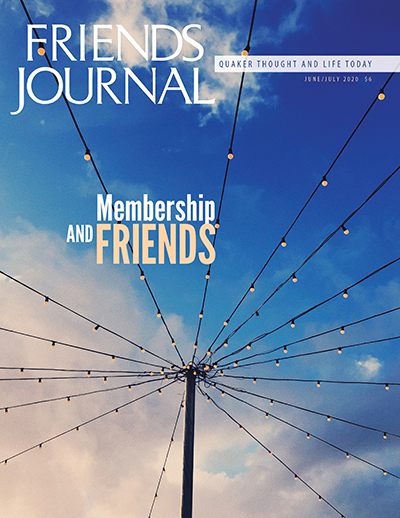The Spiritual Practice of Laying Down Memberships

When I first became my meeting’s recorder in the 1990s, I had been attending regularly for years, both before and after becoming a member. I had not paid particular attention to the membership rolls before being named recorder. Now that the list was going to be in my care, however, I took a careful look and was stunned to realize that as many as 14 out of 84 names were completely unfamiliar to me. “I wouldn’t know them in a lineup,” was my response.
How could that be possible, given my faithful attendance and involvement? In the course of talking to long-time meeting members, I learned that our meeting had never removed names from our membership list except for those who had transferred or those few who were known to have died. Ours is a relatively young meeting, and as a result, the meeting’s corporate experience and focus was on adding Friends by application or transfer. At that point, we had not had members become inactive due to age or illness, something now handled by our Pastoral Care Committee. There was no agreed-upon approach for acknowledging and dealing with lapsed memberships, and no generally shared belief that removing names of long-inactive members was something the meeting should be doing.
I resolved to see that each Friend on our long-inactive list received outreach. Clearness and Membership Committee helped. It wasn’t easy. Social media was non-existent, and the World Wide Web was new. It took our small committee three years to track people down and have several conversations with each of them about their memberships. The discussion points were slightly different for those Friends living close enough to us to become active again and those who had moved away, but the essentials were the same: the spiritual condition of the Friend, the possibility of restoring the lost relationship to meeting, and consideration of possible next steps.
Some were not surprised to hear from us. Others didn’t realize that a Quaker membership wasn’t something owned (“my membership”) and effortlessly held for life. A few transferred to other meetings. Others wrote notes to our clerk asking to lay down their membership. A surprising number, however, were reluctant to let go of their membership despite the fact that they were no longer in any meaningful way connected to our meeting and had no plan for returning to worship with us or anyone else. We still hear the same responses when we do outreach: “But I identify as a Quaker”; or “I feel like I’m a Quaker”; or “I like to be able to say I’m a Quaker, even though I don’t attend a meeting any longer.”
Helping these Friends understand the difference between sharing Quaker values or being affiliated with Friends (nothing wrong with that!) and being a member engaged with the meeting and having an obligation to contribute, serve, and participate in the life of the spiritual community, has been one of the most important parts of this work.
Helping these Friends understand the difference between sharing Quaker values or being affiliated with Friends and being a member engaged with the meeting and having an obligation to contribute, serve, and participate in the life of the spiritual community, has been one of the most important parts of this work.
The meeting gradually came to accept that it is in good order to remove names from our rolls when memberships have truly lapsed, following responsible and sensitive outreach and conversation with inactive Friends. It remains a time-consuming and difficult process, however. Nobody likes making these calls. It’s discouraging when there is no response to letters, voicemail messages, and emails. The meeting can find it hard to let go of Friends who are fondly remembered from the years in which they were active, and may feel as though we are judging when we ask the business meeting’s approval to lay down a membership. Often there are personal ties with the meeting that remain after the Friend has lost all interest in the meeting itself. Not every “approved” is voiced with equal conviction.
Finding the right language has helped. Even informally, there is never talk of wheat or chaff, or deadwood. We talk about strengthening our membership list when we say why we are calling, or when we report to business meeting. To the Friends themselves, we talk about the nature of their connection to our meeting, or its absence. To the meeting, we talk about our membership list having integrity, thereby supporting the concept that membership has authentic meaning.
I often say that the annual recorder’s reports are an effort to hold up a mirror to the meeting and see how clearly our membership list reflects reality. “Quakerism is about where you are now,” one wise Friend observed during a discussion about a formerly very active member whose dry spell had extended on for years. At some point, the vanishing point may be reached. In answer to one question during a recorder’s report, I gave inverted homage to Supreme Court Justice Potter Stewart’s “I know it when I see it” threshold test for obscenity. We may not be able to give one definitive description of active or connected membership, but we can see when it’s not there.
In some conversations, we hear plaintive longings for an alternative path to membership in the Society of Friends—one that is not tied to a monthly meeting. How nice it would be, we are told, if well-meaning people who agree with Quaker principles and identify with Friends could be on a list that makes them officially Quakers. Some Friends find connection and engagement at the yearly meeting level but not in their monthly meeting. Shouldn’t it be okay for those Friends to just be members of their yearly meeting?
That is not how it works, however, not in New England Yearly Meeting at least, not yet. Will that change as creative solutions continue to emerge for isolated Friends? As I am writing this, our meeting is closing its physical doors for the duration of the coronavirus crisis and holding meeting for worship, pastoral outreach, and committee meetings through a videoconferencing platform. It could be that new frameworks for Quaker engagement will emerge out of this experiment. Yet the Friends testimony of community, as we have come to know it experientially, is one that is lived out and practiced in a meeting in which each member knows and is known by all. We are called to be “members of one another” in the words of the title of Thomas Gates’s Pendle Hill pamphlet. Membership is not a name on a list or an abstraction but a messy reality lived out (or not) in many ways.
Memberships are carried differently from Friend to Friend. Not everyone can participate equally in serving the meeting on committees or contributing to it financially, but all members can find ways to engage even if they no longer live close by, especially as we grow in our use of technological tools. Over time we have learned to look at the nature of connection to the meeting with a generous eye. Some of our members move away but ask to remain members, perhaps because there is no suitable meeting nearby. What is a meaningful connection to our meeting in that case? Maybe it’s subscribing to our listserv; visiting when in the area; attending worship with us online when it’s available; making a donation if able; and most importantly, providing the meeting with occasional updates and current contact information. For local Friends, it’s all of the above, but instead of visiting when in the area, it’s coming to meeting at some intentional interval. For a member who no longer gets to meeting even occasionally, we suggest a reasonable interval and see how that goes over. (“If you can’t imagine returning to meeting weekly or monthly, how about coming once a season?”)

We make it a practice to review the list continually and reach out to Friends we do not see at meeting. We always urge a return to worship, with us or another meeting or faith group. We encourage taking the step of writing to the meeting and laying the membership down when appropriate. Only as a last resort do we ask for the meeting’s approval to lay a membership down. Whenever that happens, there are always questions: Have we reached out enough? Does the Friend know we are considering laying the membership down? There is usually some pain expressed, especially when the Friend is lovingly remembered. In that instance, we sometimes take a few minutes to share memories of that Friend’s time in meeting.
What have we learned about good process in the course of our experimentation? Our yearly meeting’s Faith and Practice is clear on the point that any member who “habitually neglects attendance at meeting, fails to contribute to its support, or in other ways evidences a lack of unity with Friends” should be removed from the membership list. As to how to actually carry out that process, less help is available there or elsewhere. An Australian Friend, a recent new member, observed to me that Quaker guidance on becoming a member invariably offers pages and pages of process and excellent advices and queries, while in marked contrast, there is little help for Friends seeking to determine if a membership is no longer alive and how to work toward bringing it to a close. One big difference between initiating and closing memberships is the lack of a clearness process. When local inactive Friends have resisted our laying down their membership, our committee has sometimes invited them to have a clearness committee with us. That reminder about Quaker intentionality and discernment seems to make the point clear. No one has ever taken us up on that offer!
Here are some things that our Clearness and Membership Committee has learned:
Reach out every year, two at most, to members you don’t see, and track the response. Adapting a form letter is okay; committees need to make things simple for themselves. Create a spreadsheet if you need to.
For those living at a distance, outreach may be an email or Christmas card with an enclosed note. Is the Friend attending a meeting where they are living? Is a transfer being considered? For those members who are not sojourning elsewhere and supporting that meeting, are they in the position to make a donation to the meeting that holds their membership? Always urge a visit whenever in the area. Offer contact information for a conversation. Check in as a committee after a month or two: Who responded to the outreach? Who did not?
For local Friends, a phone call may be more useful in establishing what is going on. People don’t pick up the phone as readily as they used to, however, and sending a friendly email asking for a phone date can help make a conversation happen. Again, check in with the member’s spiritual condition. Always encourage a return to meeting, or at least a visit. Could the committee help in any way with the Friend’s discernment about their relationship to meeting? What is the next step? Sadly, it is our experience, with a few exceptions, that a prolonged and complete break with the meeting is usually final. A return to active engagement nevertheless remains our hope for every absent Friend.
Start with the obvious when deciding whose name to bring forward. If friendly emails and letters to a Friend bounce back or are unreturned for three to five years, it’s time to communicate that the meeting may lay the membership down if connection isn’t re-established. After several attempts to connect, we send a “final notice” email. After the usual pleasantries and before closing with the usual hope to see the Friend visit, we include something like the following:
We have done our best to make contact but have not been successful. If we don’t hear back from you by ___, we will consider your membership lapsed and ask meeting’s approval to lay it down.
Often that is enough to bring a response and action from the previously unresponsive. Even Quakers can sometimes benefit from deadlines.
Build on any connection: If the Friend donates but does not attend, that shows belief in the importance of the meeting and its work; build on that: “We’d love to see you at meeting! If you can’t come, do you want a visit?” Maybe the Friend shows up only at the Christmas Eve worship, common in all congregations; it’s still something to build on. We have members who faithfully serve on committees but don’t attend meeting for worship. When a Friend’s attendance has fallen away, it can feel awkward to return and face the inevitable attention and questions of happy meeting members during fellowship hour. Talking about that experience can help diffuse that anxiety. Acknowledging any reservation about returning and persisting in encouraging a member to “just come anyway” is important, despite objections. When Friends report that they are staying away because the meeting has somehow disappointed them, ask if they would like Ministry and Counsel to be in touch with them. Members who are holding grudges with the meeting and staying away can be asked to take some responsibility toward healing steps, if the meeting is reaching a hand out with the invitation for listening and engagement. If there is no willingness on the member’s part to make an effort to overcome obstacles to returning to meeting, it’s time to have an unflinching conversation about the mutual responsibilities of meetings and members.
Building a practice in which we close memberships with some of the same attention and process with which we open them has helped our meeting clarify for itself a baseline understanding of membership.
Building a practice in which we close memberships with some of the same attention and process with which we open them has helped our meeting clarify for itself a baseline understanding of membership. Sharing in business meeting the reasons for laying down a membership reminds all present of the responsibility to keep our memberships alive or be willing to let go. It’s important and often difficult work that has been and continues to be a spiritual journey for the community.




Comments on Friendsjournal.org may be used in the Forum of the print magazine and may be edited for length and clarity.